Mastering Chess strategy is the non-plus ultra for many Chess players. This means having a deep understanding of the game and outplaying your opponents with deep plans and ideas.
But before getting there, you should learn the basic chess strategy. And in this article, I will teach you 5 beginner chess strategies that will take your game to the next level!
Having those basic principles to rely on will make it much easier and more fun to play chess.
You will also have a toolkit to beat your friends, family, or online opponents more easily.
Here is what you will learn in this article:
- Control the center of the Board
- Play with all your pieces
- When in doubt, improve your worst-placed piece
- Simplify (=exchange!) when you are material up
- Move pawns only when necessary, they can’t move backward!
Now, let me explain why you should use those basic chess strategies in all your games and how you can do so.
Chess Strategy #1: Control The Center Of The Board
You might have asked yourself why most people suggest you start with either 1.e4 or 1.d4.
The reason is pretty simple: controlling the center of the board is crucial in chess.
That is why you should fight from move 1. for central control. And with 1.e4 or 1.d4, you do exactly this. You take some valuable squares in the center under control and open up the way for your Bishop to develop towards the center.
But why is the center so much more important than either side?
Here are the reasons:
- By controlling the center you can at any time switch your focus to the King- or Queenside.
- Pieces in the middle of the board have much more influence and potential than those on the side.
- Controlling the center helps you to win more space for your pieces.
- Controlling the center also diminishes the scope of the pieces of your opponent.
To visualize the difference between center vs side we can look at two totally different knights:
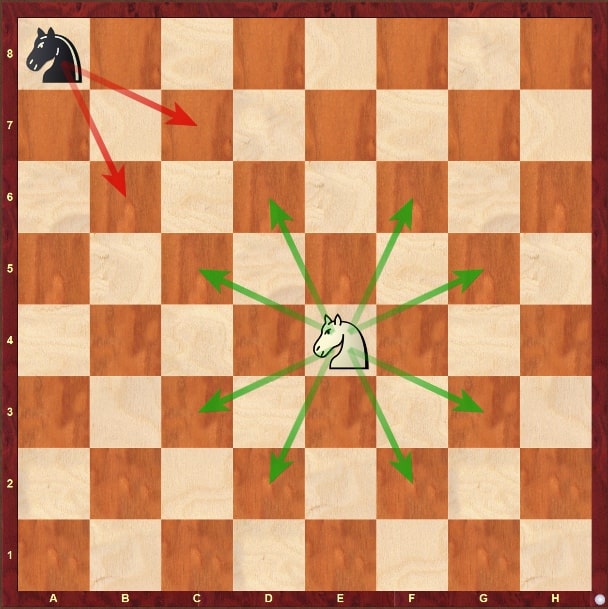
The white knight posted centrally on e4 has 8 squares under control. That is why Chess players sometimes refer to a knight in the center as an ‘octopus’. Now compare it to the absolutely sad knight on a8, which only controls 2 squares.
The same piece, but a 4x difference in controlled squares (and possible destinations)!
Remember this: a knight is best placed in the middle 4×4, thus from f3-f6-c6-c3. On all these squares, it controls 8 squares. That is also why in the opening you should try to place your knights on f3/c3 as white, and f6/c6 as black.
In one move, you gain as much control over the board as possible.
Talking about piece placement this is a good time to go to strategy #2:
Chess Strategy #2: Play With All Your Pieces
A mistake I often see from beginners is the following: eager to immediately put pressure on the opponent, one takes a piece, moves it several times, and tries to invade the opponent’s camp as fast as possible.
While this might work sometimes, generally, it leads to losing time or that lonely piece.
I often compare this to a football (soccer for all my American friends :-)) player grabbing the ball just after the kick-off and running alone toward the opponent’s goal.
If it works, you are the absolute hero. But the chances of dribbling through 10 players and then scoring are pretty slim.
As in football, American football, basketball, or any other team sport, one should play with ALL the pieces.
Imagine yourself being the coach of 16 brave chess soldiers. Make them work together and your chances of winning are big. Make them run at your opposing soldiers without a clear plan and help, and they will probably die one by one.
Here is how you can make sure to use all your pieces and have them play together:
Move Every Piece Only Once In The Opening (A Pawn Is NOT Referred To As A Piece)
To use the maximum potential of all your pieces, you want to develop each of them as fast as possible.
That is why you should refrain from moving a few pieces several times and instead first develop all your pieces. Every time you move an already-developed piece a second time you do two things:
- Move it further away from his army
- Lose the possibility to develop a yet untouched piece
By getting all your pieces into the game fast, you can create a power-play situation. The more pieces you play with, the more squares you control and the more effective an attack will be.
Use this simple rule to play with all your pieces:
Whenever you want to move a piece for the second (or third…) time ask yourself: do I absolutely need to move that piece again (if it is attacked, yes!) or could I develop a yet inactive piece?
If it is not necessary to move the piece for the second time, refrain from it and develop a yet untouched piece.
Treat Your Queen As Your Quarterback
Sorry for all these sports analogies, but I just love sports so much…
Another mistake I see often is that amateurs try to bring their Queen out quickly.
This sounds quite logical in the beginning but can backfire very fast.
Here is why:
The Queen is your most valuable piece (except for the King, which has unlimited value). Thus, whenever your Queen gets attacked, she is absolutely forced to move again (protecting her and thus trading her for another piece would be a major loss!).
This leads to a time loss, as you need to move a piece more than once in the opening.
Now, the queen needs to move again and will remain vulnerable.
This is why I compare the Queen to the Quarterback in American Football.
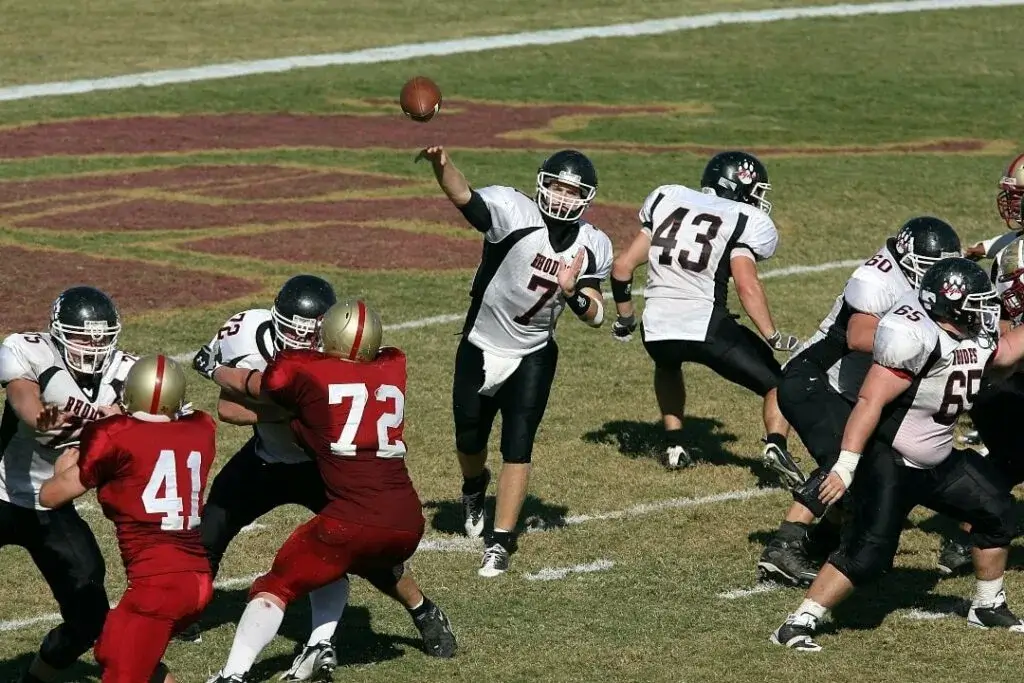
The Queen is the most important, but also most fragile piece. She can have a devastating effect on the opponent, but only out of a stable & safe situation.
She needs to be protected by her teammates so that she doesn’t get attacked early on. So make space with your central pawns for your less important pieces (Bishops & Knights). Only then bring out the Queen.
Usually one leads the attack with pawns, Knights, and Bishops. Once some damage is done, the Queen or Rooks join the party and it is game over!
Get Your King Into Safety FAST
As I wrote before, your King has an infinite value. If he is mated, the game is over. It does not matter how much material you are up at this point.
Checkmate finishes the game.
Both players will look to fight for central control early on in the game. So, your king is not exactly safe in the center of the board.
Usually, pawn trades will open up files and Diagonals, which will make the King on e8/e1 very vulnerable.
You can easily solve this problem by castling early on in the game.
You most frequently see the short castle (King e1-g1, Rook h1-f1) as you only need to develop Knight and Bishop to do so.
Opening up with 1.e4, then developing the Knight to f3 and the bishop to either c4/b5 followed by castling is a very effective way to bring your king into safety early on.
Obviously, you don’t have to do it on move 4, but try to get your king castled before move 10 in every single game.
Once you did castle, don’t move the pawns in front of your King without reason. These pawns (usually on h2, g2 & f2) are creating a wonderful shelter for your king. The further advanced they are, the more exposed your king will be.
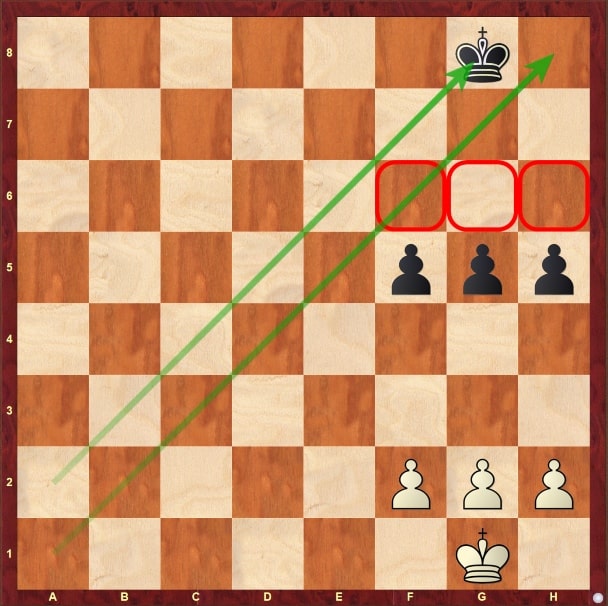
White has a nicely sheltered king, while black’s king is wide open.
A white Bishop or Queen on the a2-g8 Diagonal will attack the king nicely. Also, many squares in front of black’s king are not protected anymore: h6, g6, f6, e6.
These same squares, h3, g3, f3, and e3, are nicely protected by white pawns. The f2 pawn also shelters the king nicely from any diagonal checks. The g2 pawn does the same for frontal assaults.
The only disadvantage of the white king’s position is the possibility of a back-rank checkmate.
Imagine a black rook or Queen in the first row. The white king has nowhere to go and is checkmated.
That is why often you can make only one little breathing space with the pawn push h2-h3.
Castling also has another great effect: you bring your rook closer to the center, where it can finally get into play.
Connect Your Rooks And Put Them On Open Files
Once you castled, your rooks can finally get into play. Usually, the rooks are the last pieces to get activated.
They are most happy and effective on open files. An open file is a file without pawns on it.
Because there are no pawns, the scope of the rook is getting bigger. The more squares the rook controls, the more powerful it generally is.
Another key point is that your rooks are connected. Rooks are connected if they could theoretically capture each other. In this case, they protect each other and can work together against enemy targets.
The Perfect Way To Develop All Your Pieces
Now that you know how to develop all your pieces well, I’m sure the following example makes a lot of sense. This setup takes all the points you just learned and puts them into one.
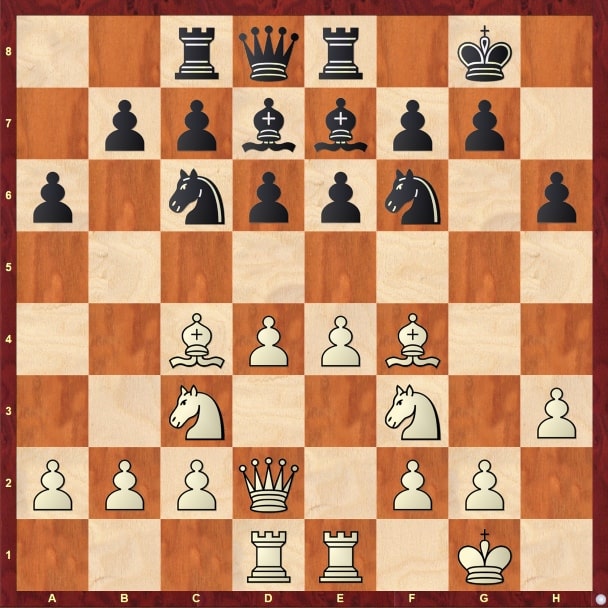
Look at the difference between the White & Black pieces. White has checked all the boxes:
- Move every piece only once
- The Queen is making space for the Rook, but not vulnerable
- The King is safe & has a breathing square on h2
- The rooks are connected and in the center (no open files yet)
On top of that white also controls the center and thus has more space and more active pieces.
The next step would be a pawn push in the center (e4-e5 or d4-d5) to further gain space, improve his own pieces and kick back black’s pieces even more.
Remember this setup whenever you play a game. I learned it when I was making my first steps and it helped me tremendously.
Most of the time, you will not be able to achieve all the points. But it is a nice guide to work with.
Chess Strategy #3: When In Doubt, Improve Your Worst Placed Piece
Now that you know the first steps of developing your pieces, you will come to a point when:
- You moved every piece once
- Castled your King
- Don’t know how to continue
Whenever you hit that roadblock, just try to improve your worst-placed piece.
So how do you know which one is your worst-placed piece?
You talk with your pieces.
It always gets a bit weird when I make this point. I know it sounds silly (and I swear I was sober when writing this…), but it works!
Once you get a feeling of where your pieces are ‘happy’ or ‘unhappy’, you won’t have many worries to find out the worst-placed piece. Then take that piece and put it on a square where it is more ‘happy’.
I’m so fond of this concept that I wrote a whole article about it.
Chess Strategy #4: Simplify If You Are Material Up
Let’s be optimistic and say you managed to control the center, move all your pieces to great squares, and won some material in the process. Great! You should be proud of yourself.
But the game is not over yet.
How do you get from being material up to winning the game?
By the method of SIMPLIFICATION.
One last sports analogy.
Your opponents get a red card. Now you are playing with 11 vs 10 men. While this is a nice advantage, it does not always have to transfer to you scoring a goal.
But if you could play 1 vs 0, it would be pretty simple to score.
So if you could just ask the opposing coach to each remove 10 players from the field, you would certainly score. Now in Football, this is not really how things work.
But in Chess, you actually can trade-off pieces. And that is exactly what you should do whenever you are up material.
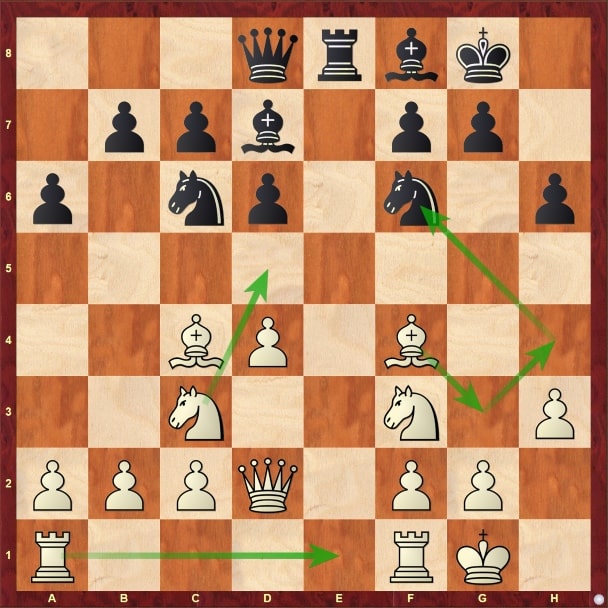
In the above example, you should try to exchange pieces as you will end up with an extra rook in the end. The first move should thus be Rook to e1, hoping to trade off the Rook on e8.
Further trade ideas would be Nc3-d5 or Bishop from f4 to g3, then h4 and take on f6.
The more pieces you manage to trade, the more desperate the situation of your opponent gets. His counterplay is now practically inexistent, as he does not have any pieces left!
Chess Strategy #5: Move Pawns Only When Necessary (They Can’t Move Back!)
I have shortly written about Pawns in the section on King safety. What makes them so special is that they can never move back.
A pawn move is the most committal move in chess.
Even if you understand that you messed up, you can’t put the pawn back where it was.
That is why you should be very careful when moving pawns.
Most beginners I see have the habit of moving pawns whenever they don’t know what to do. They probably think something along the lines of “as the pawn has the lowest value, even if I mess up I only lose 1 point”.
This is partly true.
But as we saw in the section on King safety, pawns are much more than cannon fodder. They are used to gain important space, protect your King, and lead attacks.
In the opening, you move pawns to bring out your pieces and control the center. This is usually achieved by moving the e & d pawns so that the Bishops are free to go.
Once you achieve this, there is no big urge to move more pawns forward. Great guidance to rely on is the following:
Whenever ALL your pieces are in perfect places, pawn moves can have a devastating effect.
A lonely pawn will not really disrupt your opponent.
But with the help of your full army, you can think about advancing a pawn to disrupt your opponent further.
Bonus Chess Strategy: Don’t Play For Cheap Tricks!
The smell of a fast and easy victory can be so tempting.
But relying on cheap tricks will give you only short-term pleasure and long-term pain.
Why?
Because while a trick might work once or twice, it won’t work always. When your opponents get stronger, your tricks won’t have the same effect anymore.
Thanks to your quick wins you will win some rating points, but you actually won’t improve at all.
Winning with known tricks will make you stuck at the same playing level, even if your rating might increase temporarily.
And whenever the moment hits that your opponents are too strong for these silly tricks, they will outplay you mercilessly.
That is why I wholeheartedly recommend you try to work on the basics of chess and improve your knowledge and skills of the game. Better knowledge and skills just last so much longer than silly opening traps.
The earlier you learn this, the better.
You might lose some games in the short term, but after some time people that managed to beat you will think “why is this player suddenly so much better than I am?”.
Don’t be on the wrong side of things.
And yes, it is totally fine to once trick your best friend just for fun. Chess improvement can be fun, so do it occasionally. Just don’t rely on tricks in most of the games!
Along with the idea of not playing for tricks comes my deep belief in focusing on the process, not the results.
Take your defeats lightly and be ready to lose some games. As long as you keep learning something, it is all good! Results will come AFTER you developed as a chess player.
Conclusion
Chess is a very complex game. But with some basic strategies, you can massively improve your understanding & results.
You should:
- Control the center of the Board
- Play with all your pieces
- When in doubt, improve your worst-placed piece
- Simplify if you are material up
- Move pawns only when necessary
Want to improve your Chess? I have created the best all-in-one Beginner Course on the Chess Market. In it, you’ll learn all the fundamentals, strategies, and tactics you need to reach a 1200 rating and beyond.
Learn more about Beginner Chess Mastery – Reach 1200 Online.
Sincerely,
Noël
PS: If you just want to get some more free chess tips, consider signing up for my Free Newsletter. You’ll get a weekly Friday email consisting of ideas on how to improve your Chess.